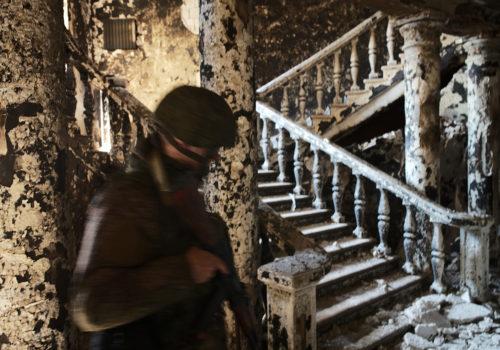The Hotel Fontfreyde, Clermont Ferrand Photographic Center presents until June 1st an exhibition by Yan Morvan titled Résistances Mémorielles. He presents it like this.
On the razor edge
The bus of the “special envoys” of the “international” press went from Teheran to Shatt-el-Arab, the scene of the battle between Iraq and Iran for the possession of the oil terminals. We stoped, at night, on a height overlooking the towns of Khorammshar and Abadan. The fighting had been going on for at least three weeks.
This was my first conflict. It is October 1980. With a colleague from the BBC we observed the raging battle from our promontory. The horizon is fiery red over 180° and an infernal rumble constantly punctuates the sound of the cannonade. We are more than 100 km from war, death is already here.
In this infernal cauldron thousands of men are fighting and dying.
The next day we were in Khorammshar. A lull allowed us to “visit” the front to take photos and film. Children, armed like adults, came out of the holes, gave us the victory sign and smiled. We left very quickly, the bombings had resumed and the press officer wanted your safety as much as his life.
August 2023, the Bakhmut front in Ukraine is not accessible to “unaccredited” journalists.
With a colleague Nicolas Cleuet, we put on “Volunteer” “uniforms” to access the zero lines, facing the Russian invader.
The guys in the trench are in shirt sleeves, slippers on their feet. They feed an old Soviet 120mm mortar with American-made rockets aimed at enemy lines located four or five kilometers away.
Ammunition is limited, there is hardly any. After each departure we hear the drone opposite which comes to try to locate the origin of the shots. Everyone throws themselves on their stomachs. We cross fingers. The mortar arrivals are getting closer, it is time for the “volunteers” to leave…
War is spreading. Europe, Africa, Middle East. Latent civil wars too. Identity claims, geographical conflicts. The threat has never been so close to widespread conflagration.
The sorcerers’ apprentices of geopolitics have not learned the lessons of history. After the fall of Rome, it took five centuries to find the beginnings of a Western renaissance. The traces are meager, writing, documents, architecture.
Paradoxically our time is increasing the number of pieces of information, in bulk, without comments, or even biased opinions depending on each camp.
“The first casualty of war is always the truth,” professed Rudyard Kipling. He forgot humans, flesh for carnage, hostages of vanity and the pride of the powerful.
All wars are alike, in all latitudes and in all tropics.
To photograph war is to accumulate the tragedy and absurdity of a mad and desperate humanity running towards suicide.
“Homo homini lupus” said the ancients, animals kill to defend themselves or to eat, not for pleasure.
Photographing war means accumulating testimonies, enriching the memory of those who will come, hoping that one day, perhaps, peace will return.
Yan Morvan : Résistances Mémorielles
March 7 – June 1, 2024
Hotel de Fontfreyde, Centre Photographique
34 Rue des Gras
63000 Clermont-Ferrand, France
https://clermont-ferrand.fr/hotel-fontfreyde-centre-photographique
















